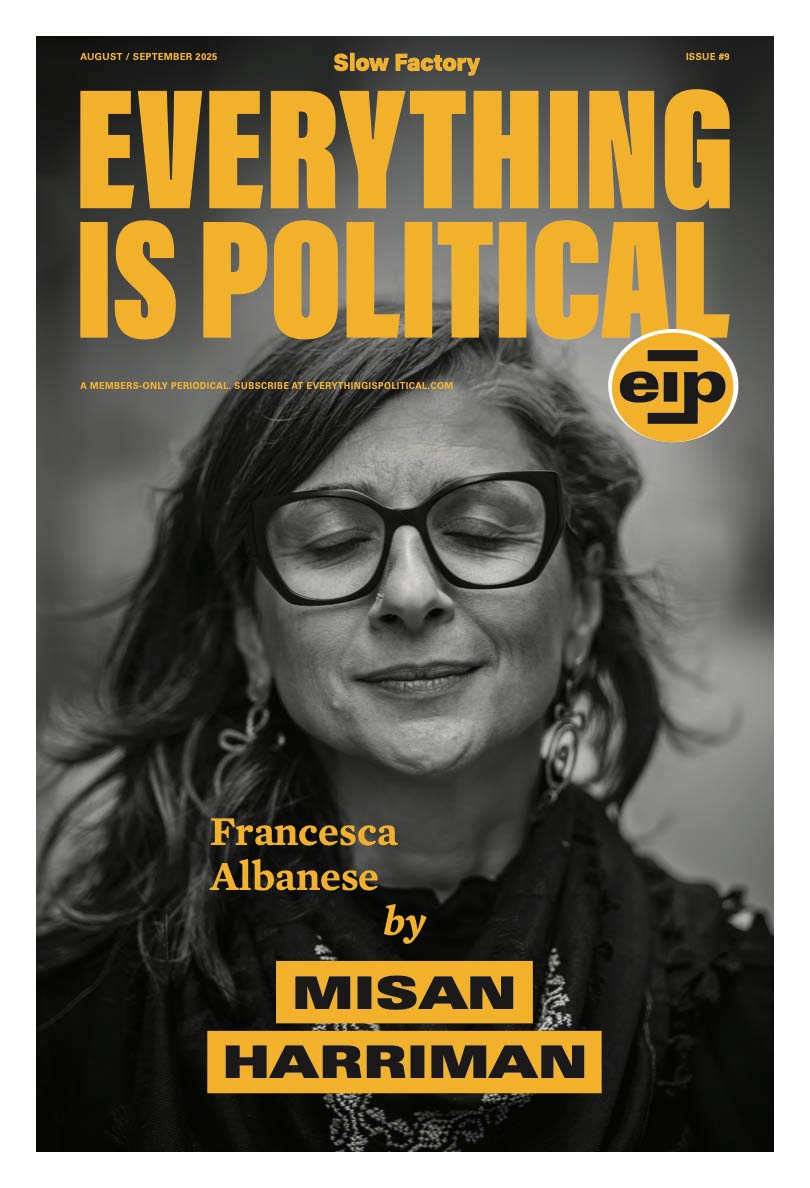Digital & Print Membership
Yearly + Receive 8 free printed back issues
$420 Annually
Monthly + Receive 3 free printed back issues
$40 Monthly
Im-Mortal Magenta
The Colour that Doesn’t Exist
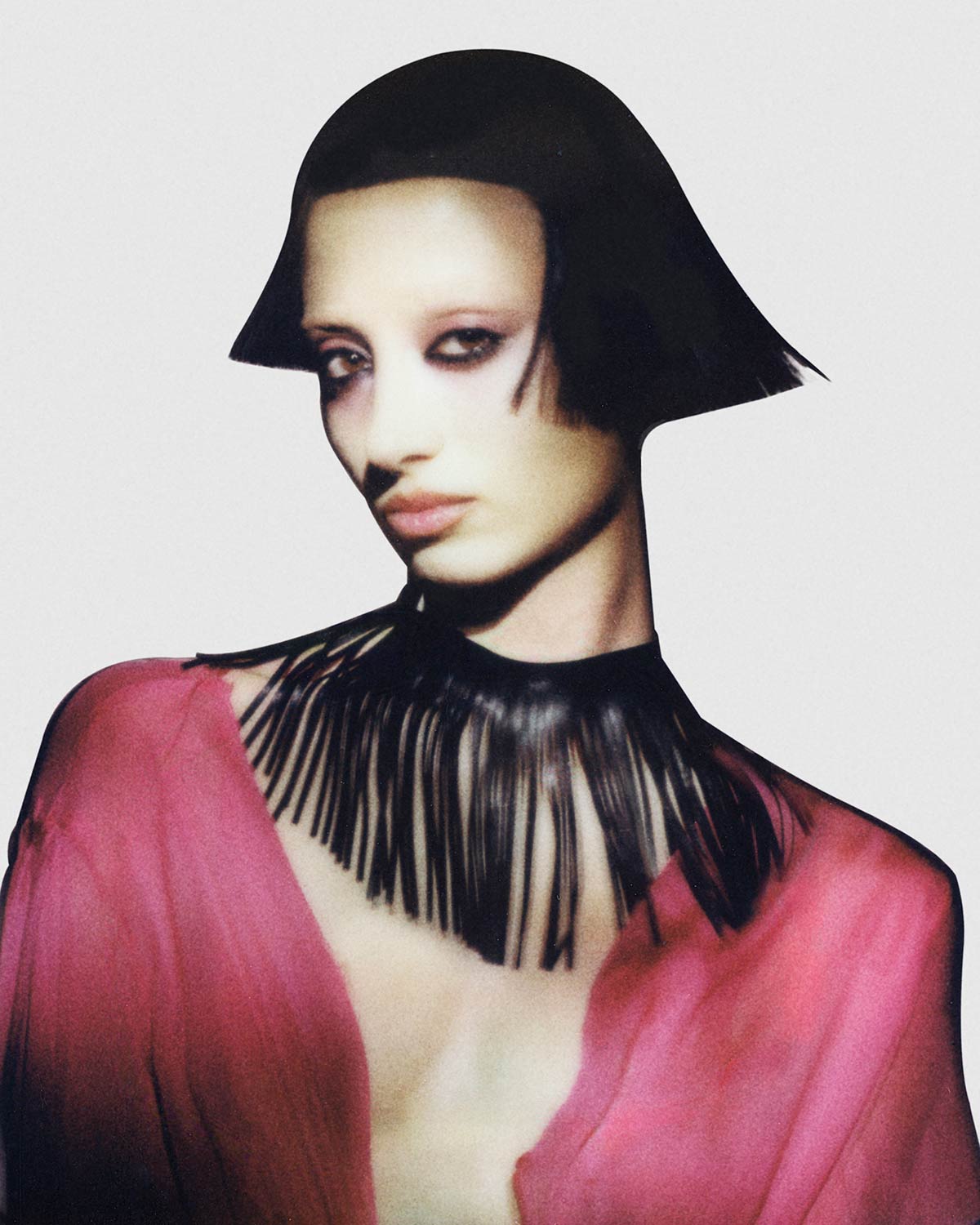
My name is Ayham Hassan. I’m a Palestinian fashion design student based in London and Ramallah. My work is deeply rooted in my personal experiences growing up in the West Bank and is approached through a critical and analytical lens. I am dedicated to challenging and reshaping my reality through the expressive medium of fashion, drawing inspiration from the social customs and evolving culture in my city. Focusing on exploring the rich craftsmanship in Palestine, with a particular emphasis on tailoring, textiles, and draping. I actively collaborate with local artisans to incorporate their traditional techniques and expertise into my design and production process. By doing so, I aim to contribute to the preservation of Palestinian crafts and enhance the overall production cycle in my country, ensuring that these invaluable skills and traditions do not disappear, especially in the fast- evolving world we live in.
The unique aesthetic of my work is deeply influenced by the environment in which I was raised, characterized by a raw, primal, visceral, and earthy quality. This aesthetic is a reflection of the challenges I faced growing up under Israeli military occupation. To me, fashion is not simply a form of self-expression; it is a means of protection, at times from societal pressures, and always from the harsh realities of military occupation.
I firmly believe in the transformative power of design as a force for positive change and progress. Through my work, I seek to disrupt the fabric of constructed life in my community, prompting individuals to confront the pressing issues within Arab and Palestinian societies. By building upon traditional techniques and infusing them with innovative and sustainable production methods, I am committed to elevating design and industrial independence in Palestine and the Levant area. Additionally, I aspire to integrate the often-overlooked Palestinian identity into the global fashion industry.
إنهاليستثوبًاأخلعهاليوم،بلجلًداأمزقهبيد ّي.ولاهي فكرة أتركها ورائي، بل قلبًا حلو بالجوع والعطش
“It is not a garment I cast off this day, but a skin that I tear with my own hands. Nor is it a thought I leave behind me, but a heart made sweet with hunger and thirst.”
— Khalil Gibran, The Prophet (1923).
I have developed a collection that powerfully showcases my conceptual process for each look, utilizing primarily deadstock materials and end-of-stock leather skins. My selection includes an array of soft silk chiffon, woven silks, and vibrant shades of magenta. I have incorporated silk organza, rubber bands, faux leather cords, and knitted wool from Palestine. Additionally, my materials feature tulles, paper silks, metal embellishments, pleated paper, and hand-stitched woven cotton from Palestine, all contributing to a distinctive and impactful aesthetic.
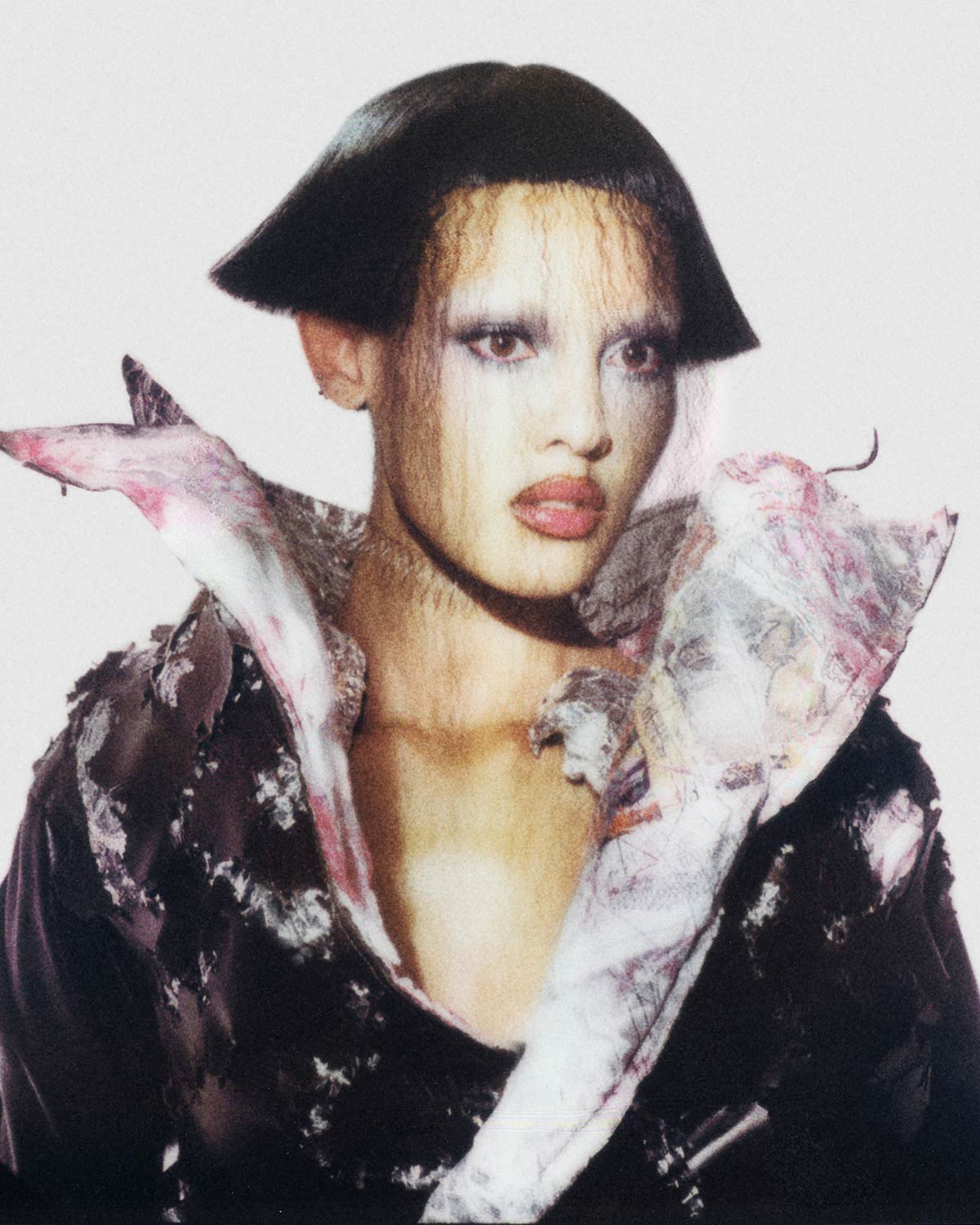
Firstly, I confront the issue of cultural sustainability against the backdrop of the horrific genocide occurring in Gaza and the West Bank. My work is deeply inspired by the Magenta weaving technique and cross-stitch embroidery, which have cultural roots in the city of Majdal in Gaza. Regrettably, the last family practicing these traditional crafts faces severe intimidation from Israeli forces, with some members displaced to Egypt. Through the use of symbolic color and powerful motifs, I assertively document and celebrate the uniqueness of this heritage in every look of my graduate collection.
Secondly, I take a firm stance on environmental sustainability in the construction of my pieces. I have developed innovative zero-waste cutting techniques for each look, focusing intently on utilizing deadstock materials and leftover leather skins. My project has garnered sponsorship from Last Yarn Fabrics and support during my placement at Maison Givenchy. Together with my mother, I have crafted a wool knit scarf using wool sourced from local Palestinian shops, all while operating within a reparative production cycle. Furthermore, I proudly collaborated with eight exceptionally skilled female artisans specializing in cross-stitch embroidery; for them, this craft is a vital source of income for their households. In essence, my graduate collection is a powerful celebration of creativity and craft preservation from my hometown. It unapologetically addresses the devastating effects of genocide and war on the survival of a vibrant culture.
Incorporating my identity into my work is not just important; it is essential. I am committed to confronting socio-political issues within the fashion landscape and raising critical awareness of the industry’s environmental impacts. Through my designs, I will deliver bold statements that inspire change, foster meaningful dialogue, and promote a more thoughtful and responsible approach to fashion. My aim is to craft pieces that not only enhance personal expression but also challenge the status quo and elevate our collective voice.
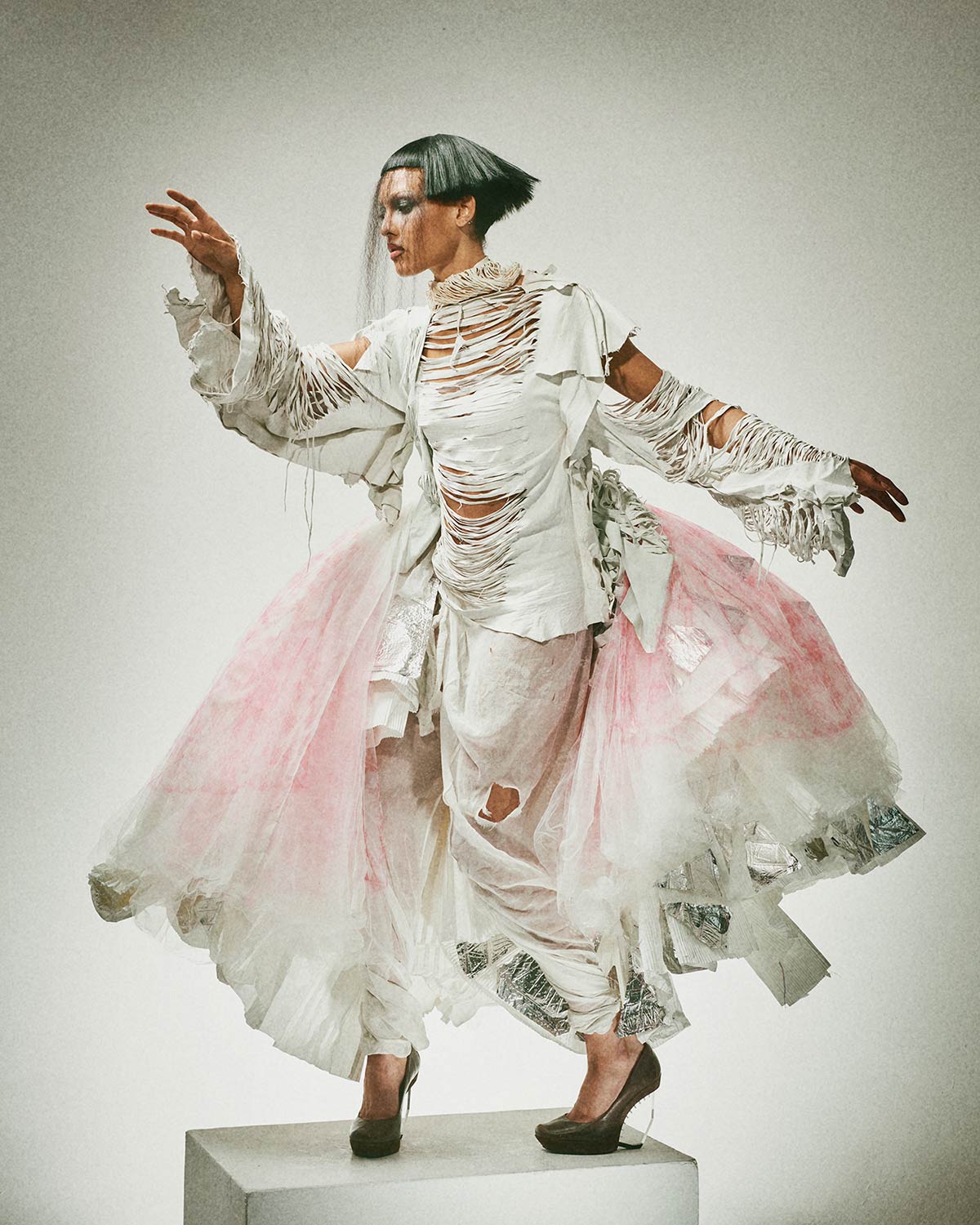
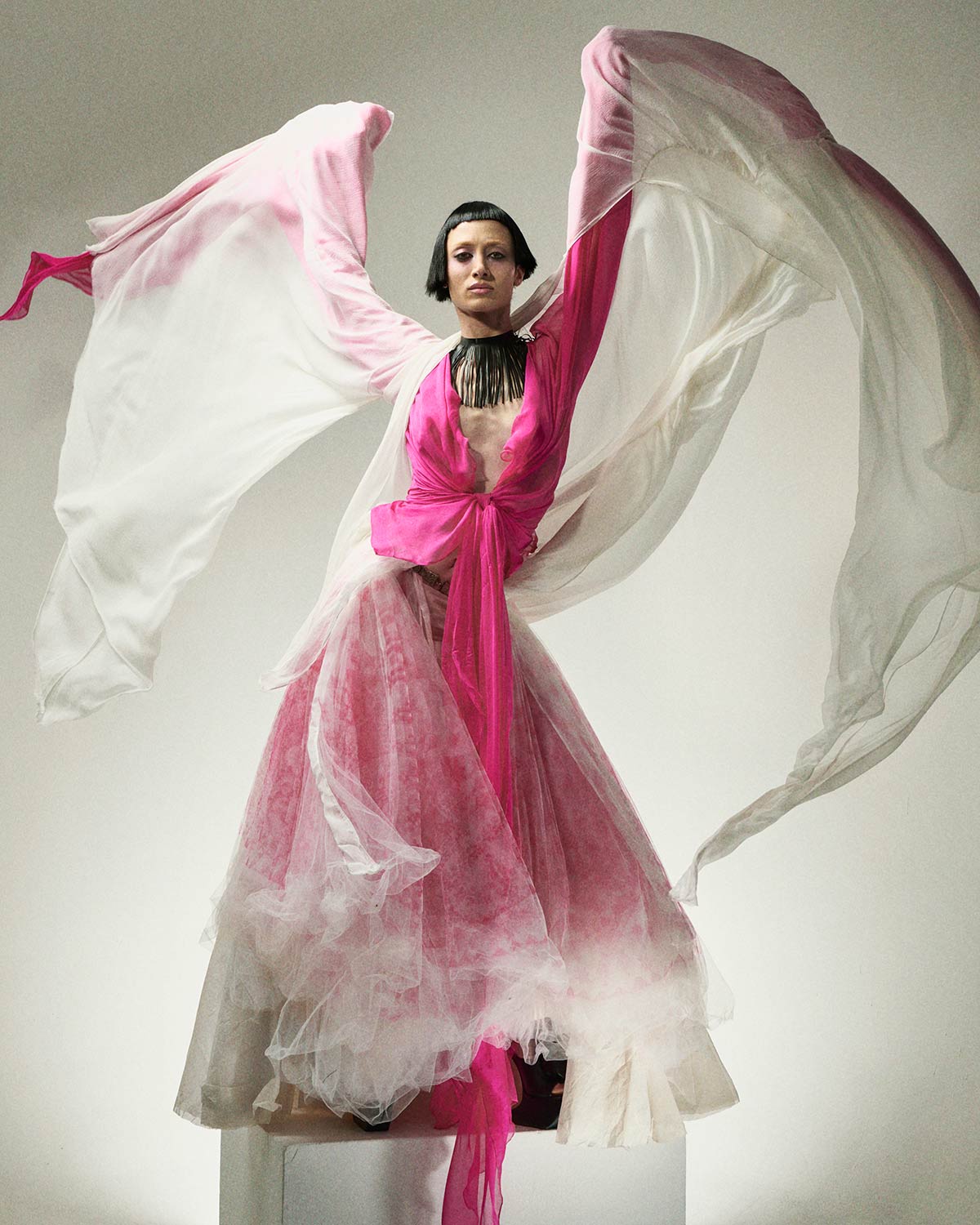
CÉLINE: You moved to London four years ago to follow your dream. What was your dream?
AYHAM: My dream was always fashion. I’m fascinated by the incredible designers in London, like McQueen and Galliano. In Ramallah, there was not much of a scene. I started studying design at Birzeit University in Ramallah, and met the most incredible artists, like Amer Shomali and Omar Joseph Nasser Khoury (?). I was so privileged and honored to be taught by them. I ultimately realized that I wanted to have a career in fashion, and the goal became CSM (Central Saint Martins in London).
CÉLINE: How was the process to apply?
AYHAM: It was insane. It was literally like doing the impossible. But I applied, and got in. Then I had to face the complications of going and getting funded. At that time, I had incredible mentorship from Nol Collective (an intersectional feminist & political fashion collective out of Palestine) who were incredibly supportive. However, unfortunately, the government in Palestine does not acknowledge fashion as a serious topic, like art… There is an amazing art scene in Palestine. Just not much fashion. So, I started doing crowdfunding. The crowdfunding got picked up by people at Dazed (digital magazine - dazeddigital.com), Bella Hadid, and a lot of people in the industry, who shared it on Instagram. It was so humbling… The al-Quds al-taw’am (?) made Palestine kind of mainstream on Instagram. There is an interesting evolution in terms of what resistance is and how to communicate what we are fighting for and how to communicate our ideas on social media. Emma Davidson (Fashion Features Director at Dazed Media) wrote an article in Dazed that literally changed my life in one night. I got all my funding sorted out, and I got my sponsorship. Emma called me and said, “Prepare yourself… make sure you have an umbrella. London is rainy.”
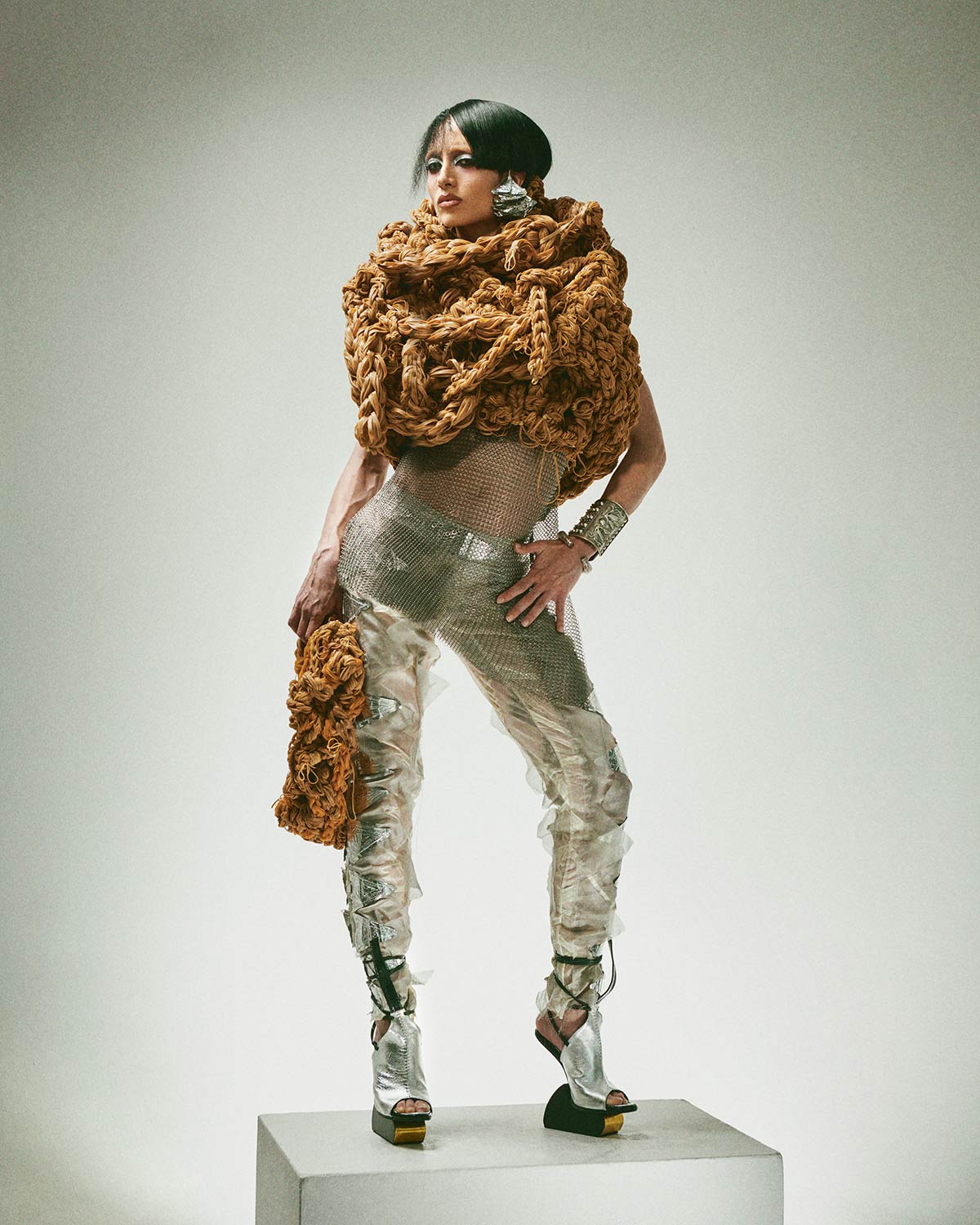
CÉLINE: Your recent collection went viral, and it was in every single news outlet. I was so proud to see it… from GQ to Vogue to literally, everywhere. How was it for you to put out a collection? It’s so personal. Tell us a little bit about the process behind it, and the work in Palestine, the embroidery, the work with the oversized fabrics. Tell me about how you built this collection, and what it means to you.
AYHAM: At that time, with the genocide in Gaza and the effect of that in the West Bank and in the occupied Palestinian territories in the north, it was so insanely tough and difficult… We grew up with our families, our grandparents telling us horrific stories. And there’s so little documentation of what happened during the Nakba, and the Naksa, the Intifadas, and everything connected to Palestinian resistance. The late Ottoman Empire also fucked up the situation and made it possible for Israel to come about. I was studying and watching documentaries, listening to stories. What happened in Gaza happened before, and it’s happening again. And even worse. I was in shock. I was in mourning, and huge suffering, and I didn’t understand how to actually support the resistance other than posting and sharing and going to protests with my friends…
I’m in fashion, I’m a creator. I have a vision, and I have an identity that I want to share with the world. And I was aware that I needed to do something. I needed to reflect on my emotions and process everything. It was so tough to do this at UAL (University of the Arts London). Unfortunately, the show was sponsored by L’Oreal, which is complicit in the genocide. UAL is sponsored by a lot of companies that are complicit. It was really tough. But thank God the staff members and my tutors, all of them, reached out and reminded me that I was entitled to speak out. This collection, I’m not going to lie, was created in the context of being at CSM in London, but it was unapologetically about Palestine.
I’m afraid for my family, my friends, my loved ones, in Lebanon, Syria, and Palestine. It was a terrifying time, and it still is a terrifying time. It’s insane. I needed to address this reality. I could not just look through the archives of incredible designers from the ‘50s and ‘60s. I had to address what was (and is) happening to my country. I did months of research in Palestine. I was able to go to Palestine in the summer before I started my collection. I spent months looking at archives, at imagery. I learned how people were forced to leave their countries and sent to refugee camps in Jordan and Lebanon. I was looking at all of this, and I was really overwhelmed. I thought, how am I going to approach this? It was the quest for liberation and the reality of genocide. I wanted to look at the history of Gaza. I wanted to understand the power and resilience behind it. And it clicked for me, the magenta color. It looked like a symbol of resilience, a symbol of joy in the face of suffering and the horrific things that people were going through. It’s a color of beauty, it’s a color that demands, “Look at me. I’m here!” This is what Gaza is for me, and this is how I experienced it from the West Bank.
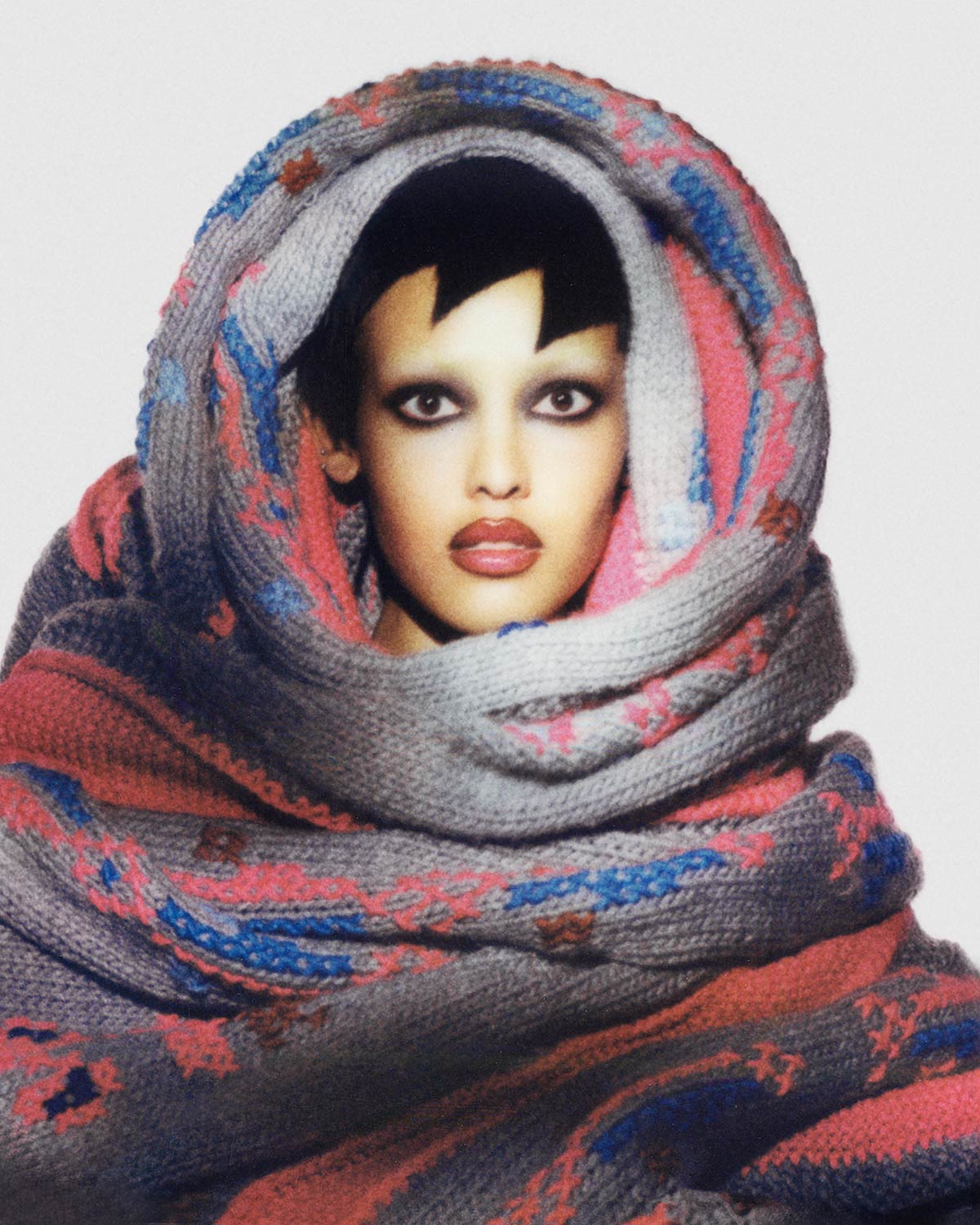
CÉLINE: Where did you start? Was the tatreez (Arabic word for Palestinian embroidery) on your work done in Palestine?
AYHAM: Yes. Because I grew up in Ramallah, I was able to connect with a network of embroiderers who are in the villages near Ramallah and Jerusalem. I’d worked with them before on one of my samples. And I was like, let me go back to that. It was a very complicated technique to develop in a short period of time. I used the embroidery, but I applied it maximally. I changed the sizing, the scale, the colors, and the placement of it. The embroidery was done by hand by eight women who, incredibly, used images I sent them to work from. They picked up my changes immediately. And of course, my mom and my aunties, my friends, and my neighbors were also checking with them and working with them. So that was beautiful, and it was really important for me, because I wanted my textiles to come from Palestine, I wanted them to have the feel of Palestinian hands. Their resilience. This is how we fight back.
The day of the show was so special. I had Sharon Rose, an incredible friend of mine, who came from Haifa to be part of it. My first model was Palestinian as well, from Ramallah. Sadly, my family could not come, but it was really interesting to meet the people who were able to be there. However, unfortunately, the school invited a designer who had served in the Israeli military to judge… And, we didn’t (and don’t) even know whether there will be a Palestine in two years, and that’s scary. That is very scary. This collection came from my reflection on that situation. Every look in the collection was specifically referenced with keywords. It told a very strong story, and the magenta was really striking. One of the pieces was a net that my mom knitted and embroidered by hand. I wanted her to be a part of it, and I wanted her to see it… we are in 2025, it’s not that complicated to travel from continent to continent, but this is how difficult it is in Palestine. You cannot actually travel easily. You have to go to Jordan. You have to cross all these checkpoints.
The Ottoman Empire made sure to kill the industries and starve the people who worked with silk in Lebanon. There’s a huge story about mulberry trees, silk, and the famine that the Ottoman Empire caused, which severely impacted the Lebanese people. And similarly, in Syria… so, we became the ones to provide the silks. There is a connection through the fabrics and the colors and the threads between our countries and our nations… People say I’m Palestinian, but I’m probably more Lebanese, more Syrian. We are all of the same ethnic makeup. When we look at the collection, we see this cry, this loud scream, this creative explosion of, look at me, look at me, I’m here… and it’s extremely moving. I think that’s why it’s touching a lot of people, and it’s going viral, because people need to see this in a way that is creative. It’s a counterbalance in such a powerful way to all the horror we are seeing.
Fashion is art to me. This virality has shown me that my work resonates on so many levels. It’s fashion, it’s design, it’s an explosion of creativity, and passion, and gender and sexuality expression. My collection is addressing the reality of genocide, the quest for liberation, and the inevitability of liberation. This is a collective liberation movement. It’s our right to scream and say, this is not okay! It is a genocide. It’s ethnic cleansing. During the show, they closed every door, they locked everything, they had police officers. My models were like, we have to do something. We have to carry signs. We have to show that this is not okay. My models, all of them, carried signs that said, “Boycott L’Oreal,” and “Free Palestine.” It was not even my suggestion. It was the models who decided to do this.
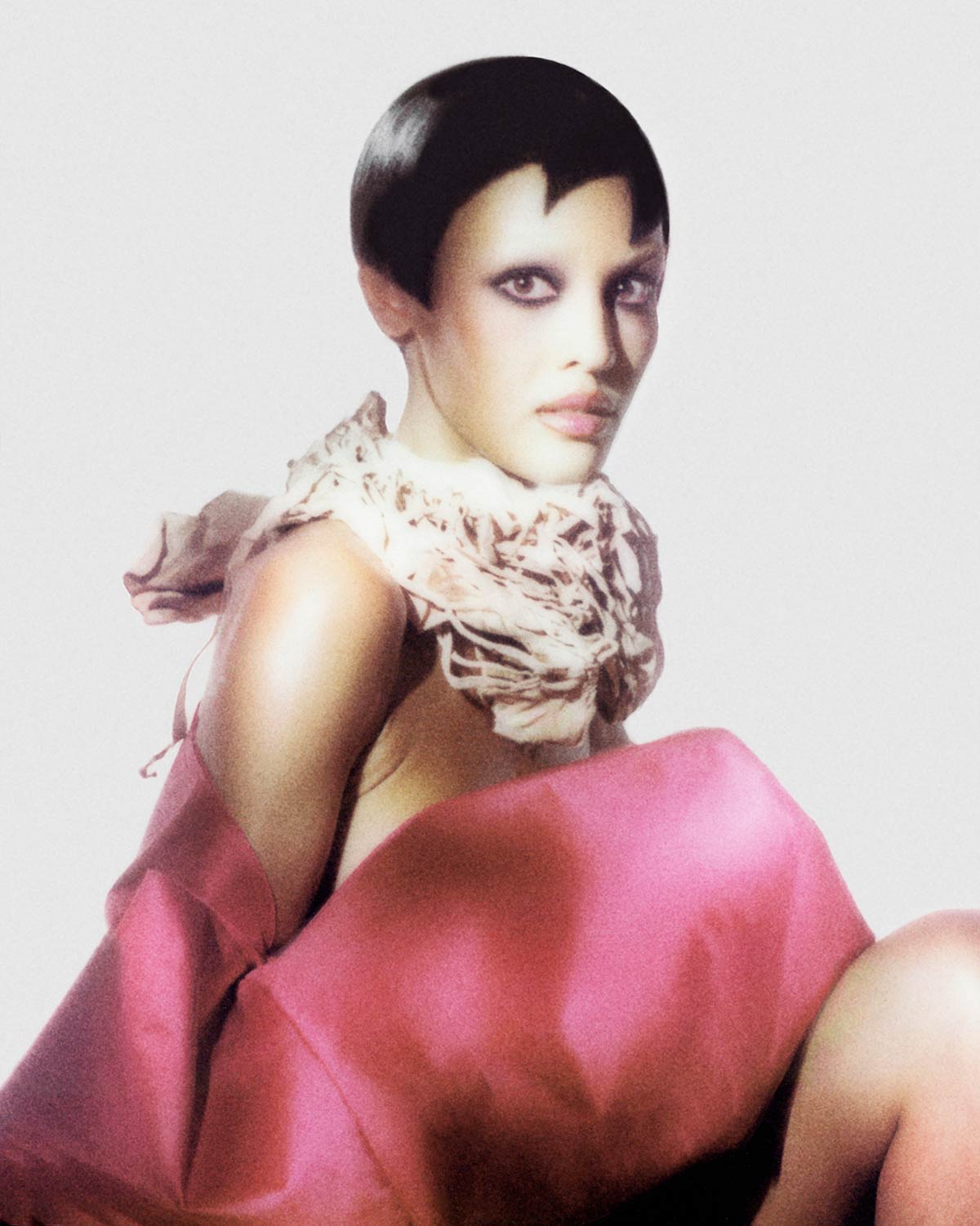
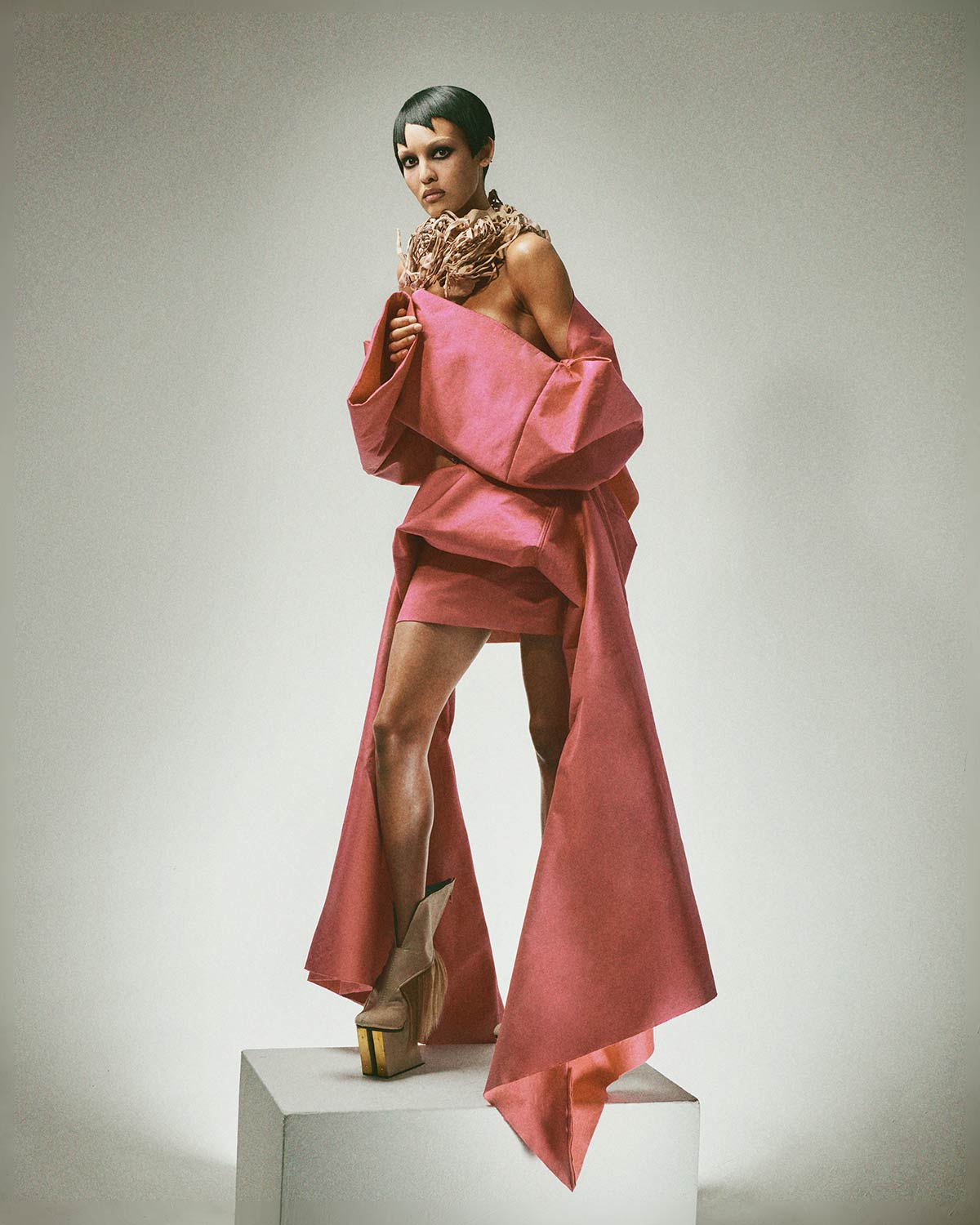
CÉLINE: Do you think your brand is punk? Do you fall in the punk lineage?
AYHAM: Maybe in the spirit of punk… it’s rebellious. We are living in very uncertain times in all industries. It’s very scary. I said everything I wanted. But unfortunately, they always tone it down. Change it a little bit. Of course, the staff are incredible and very pro-Palestinian, all of them, the tutors, students, everyone is… but the whole UAL multinational company… you just realize you don’t matter to anyone. They had a course fees reduction for Ukrainian students because they are going through the war, and I, as a Palestinian, didn’t receive any reduction. That was a huge what’s the deal? And why the hell do we have to have funding from L’Oreal to do a show to exhibit the most incredibly talented students, but we are living in a time if you’re not in that show, you’re not going to be shared. If you’re not posted, you’re not going to get a job. If you’re not shared, people are not seeing your work, and we deserve to show our work. You know, we worked super hard on it…
CÉLINE: What’s next for you? Where are you headed?
AYHAM: The ultimate goal is to open my own collective and work with students, work with designers and freelancers and artists in Palestine, in Lebanon and Syria, and Jordan, and hopefully make my statement in the industry. I have so much to say. I’m experiencing a genocide. My family is in Palestine. I am from Ramallah. I’m seeing all these stories, and at the same time, I have to be inspired. I have to be creative. I have to be on my best behavior, to be every day doing my best work. And I have to use different words to speak to people, and I have to approach it differently and humbly tone down. So which one? If it’s about being Palestinian, yes, it is about being Palestinian, about having to discuss really harsh topics in a fashion context. And this is what I’m providing to the industry. This is what I’m going to do every single season, every single year. This is what I’m going to speak about. This is what I’m going to approach.
CÉLINE: If you were to work at a big house, at a traditional fashion house, is there one you would want to be a part of?
AYHAM: Unfortunately, everything is complicit with everything horrible that I don’t stand for. And that’s why I have to do my own thing. Of course, I would love to work with Givenchy and Dior… You’re talking about years and years and years of craft, beautiful work, talented people, and the money to do the absolute best work. Unfortunately, I realized that I don’t have a space in that place because they are complicit. That’s why it is really important for me to do my own thing. I have so much to say on every topic, not just Palestine.
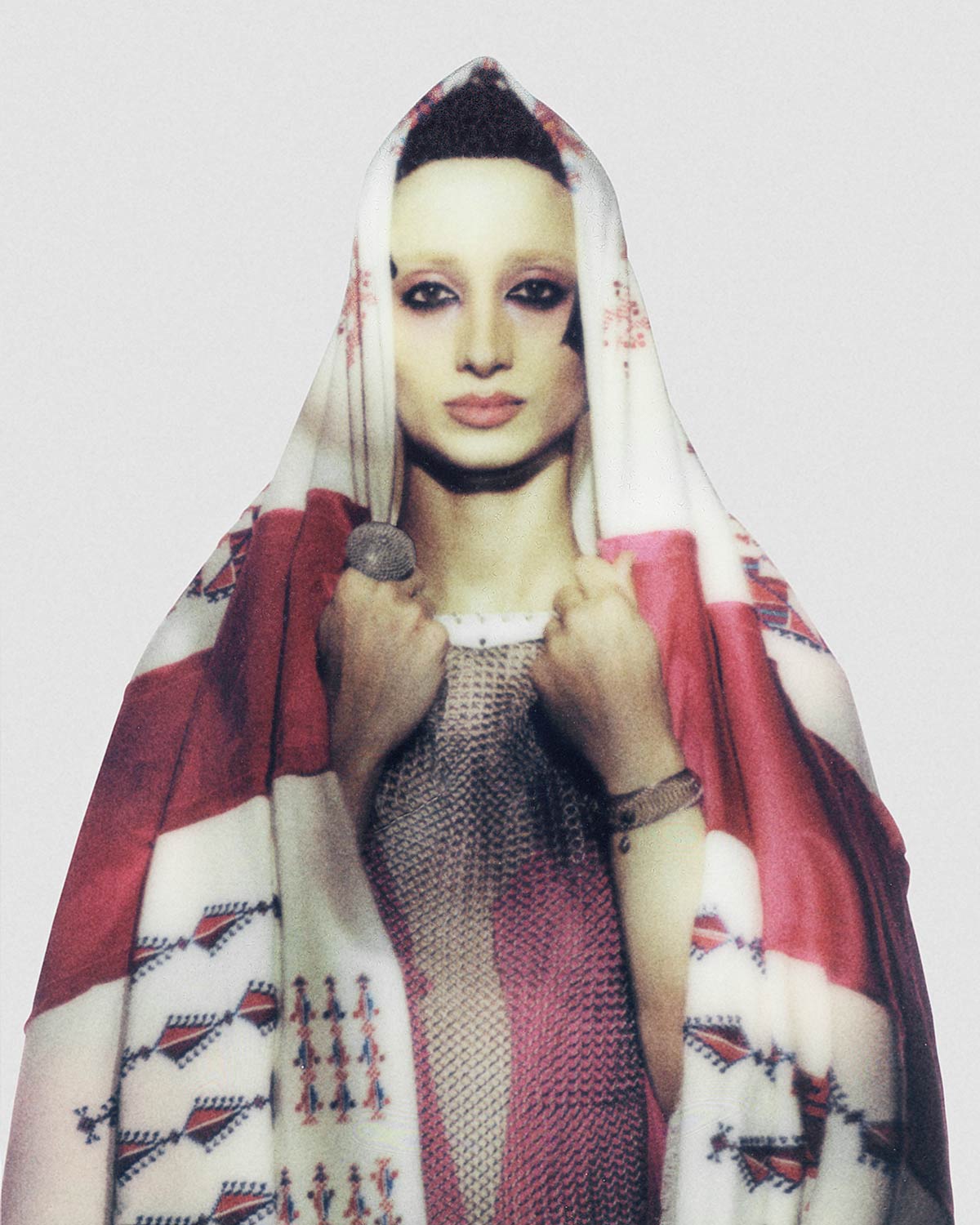
{
"article":
{
"title" : "Im-Mortal Magenta: The Colour that Doesn’t Exist",
"author" : "Ayham Hassan",
"category" : "",
"url" : "https://everythingispolitical.com/readings/ayham-hassan",
"date" : "2025-09-08 10:05:00 -0400",
"img" : "https://everythingispolitical.com/uploads/AYHAM-HASSAN-LOOK8.jpg",
"excerpt" : "",
"content" : "My name is Ayham Hassan. I’m a Palestinian fashion design student based in London and Ramallah. My work is deeply rooted in my personal experiences growing up in the West Bank and is approached through a critical and analytical lens. I am dedicated to challenging and reshaping my reality through the expressive medium of fashion, drawing inspiration from the social customs and evolving culture in my city. Focusing on exploring the rich craftsmanship in Palestine, with a particular emphasis on tailoring, textiles, and draping. I actively collaborate with local artisans to incorporate their traditional techniques and expertise into my design and production process. By doing so, I aim to contribute to the preservation of Palestinian crafts and enhance the overall production cycle in my country, ensuring that these invaluable skills and traditions do not disappear, especially in the fast- evolving world we live in.The unique aesthetic of my work is deeply influenced by the environment in which I was raised, characterized by a raw, primal, visceral, and earthy quality. This aesthetic is a reflection of the challenges I faced growing up under Israeli military occupation. To me, fashion is not simply a form of self-expression; it is a means of protection, at times from societal pressures, and always from the harsh realities of military occupation.I firmly believe in the transformative power of design as a force for positive change and progress. Through my work, I seek to disrupt the fabric of constructed life in my community, prompting individuals to confront the pressing issues within Arab and Palestinian societies. By building upon traditional techniques and infusing them with innovative and sustainable production methods, I am committed to elevating design and industrial independence in Palestine and the Levant area. Additionally, I aspire to integrate the often-overlooked Palestinian identity into the global fashion industry. إنهاليستثوبًاأخلعهاليوم،بلجلًداأمزقهبيد ّي.ولاهي فكرة أتركها ورائي، بل قلبًا حلو بالجوع والعطش “It is not a garment I cast off this day, but a skin that I tear with my own hands. Nor is it a thought I leave behind me, but a heart made sweet with hunger and thirst.”— Khalil Gibran, The Prophet (1923).I have developed a collection that powerfully showcases my conceptual process for each look, utilizing primarily deadstock materials and end-of-stock leather skins. My selection includes an array of soft silk chiffon, woven silks, and vibrant shades of magenta. I have incorporated silk organza, rubber bands, faux leather cords, and knitted wool from Palestine. Additionally, my materials feature tulles, paper silks, metal embellishments, pleated paper, and hand-stitched woven cotton from Palestine, all contributing to a distinctive and impactful aesthetic.Firstly, I confront the issue of cultural sustainability against the backdrop of the horrific genocide occurring in Gaza and the West Bank. My work is deeply inspired by the Magenta weaving technique and cross-stitch embroidery, which have cultural roots in the city of Majdal in Gaza. Regrettably, the last family practicing these traditional crafts faces severe intimidation from Israeli forces, with some members displaced to Egypt. Through the use of symbolic color and powerful motifs, I assertively document and celebrate the uniqueness of this heritage in every look of my graduate collection.Secondly, I take a firm stance on environmental sustainability in the construction of my pieces. I have developed innovative zero-waste cutting techniques for each look, focusing intently on utilizing deadstock materials and leftover leather skins. My project has garnered sponsorship from Last Yarn Fabrics and support during my placement at Maison Givenchy. Together with my mother, I have crafted a wool knit scarf using wool sourced from local Palestinian shops, all while operating within a reparative production cycle. Furthermore, I proudly collaborated with eight exceptionally skilled female artisans specializing in cross-stitch embroidery; for them, this craft is a vital source of income for their households. In essence, my graduate collection is a powerful celebration of creativity and craft preservation from my hometown. It unapologetically addresses the devastating effects of genocide and war on the survival of a vibrant culture.Incorporating my identity into my work is not just important; it is essential. I am committed to confronting socio-political issues within the fashion landscape and raising critical awareness of the industry’s environmental impacts. Through my designs, I will deliver bold statements that inspire change, foster meaningful dialogue, and promote a more thoughtful and responsible approach to fashion. My aim is to craft pieces that not only enhance personal expression but also challenge the status quo and elevate our collective voice.CÉLINE: You moved to London four years ago to follow your dream. What was your dream?AYHAM: My dream was always fashion. I’m fascinated by the incredible designers in London, like McQueen and Galliano. In Ramallah, there was not much of a scene. I started studying design at Birzeit University in Ramallah, and met the most incredible artists, like Amer Shomali and Omar Joseph Nasser Khoury (?). I was so privileged and honored to be taught by them. I ultimately realized that I wanted to have a career in fashion, and the goal became CSM (Central Saint Martins in London).CÉLINE: How was the process to apply?AYHAM: It was insane. It was literally like doing the impossible. But I applied, and got in. Then I had to face the complications of going and getting funded. At that time, I had incredible mentorship from Nol Collective (an intersectional feminist & political fashion collective out of Palestine) who were incredibly supportive. However, unfortunately, the government in Palestine does not acknowledge fashion as a serious topic, like art… There is an amazing art scene in Palestine. Just not much fashion. So, I started doing crowdfunding. The crowdfunding got picked up by people at Dazed (digital magazine - dazeddigital.com), Bella Hadid, and a lot of people in the industry, who shared it on Instagram. It was so humbling… The al-Quds al-taw’am (?) made Palestine kind of mainstream on Instagram. There is an interesting evolution in terms of what resistance is and how to communicate what we are fighting for and how to communicate our ideas on social media. Emma Davidson (Fashion Features Director at Dazed Media) wrote an article in Dazed that literally changed my life in one night. I got all my funding sorted out, and I got my sponsorship. Emma called me and said, “Prepare yourself… make sure you have an umbrella. London is rainy.”CÉLINE: Your recent collection went viral, and it was in every single news outlet. I was so proud to see it… from GQ to Vogue to literally, everywhere. How was it for you to put out a collection? It’s so personal. Tell us a little bit about the process behind it, and the work in Palestine, the embroidery, the work with the oversized fabrics. Tell me about how you built this collection, and what it means to you.AYHAM: At that time, with the genocide in Gaza and the effect of that in the West Bank and in the occupied Palestinian territories in the north, it was so insanely tough and difficult… We grew up with our families, our grandparents telling us horrific stories. And there’s so little documentation of what happened during the Nakba, and the Naksa, the Intifadas, and everything connected to Palestinian resistance. The late Ottoman Empire also fucked up the situation and made it possible for Israel to come about. I was studying and watching documentaries, listening to stories. What happened in Gaza happened before, and it’s happening again. And even worse. I was in shock. I was in mourning, and huge suffering, and I didn’t understand how to actually support the resistance other than posting and sharing and going to protests with my friends…I’m in fashion, I’m a creator. I have a vision, and I have an identity that I want to share with the world. And I was aware that I needed to do something. I needed to reflect on my emotions and process everything. It was so tough to do this at UAL (University of the Arts London). Unfortunately, the show was sponsored by L’Oreal, which is complicit in the genocide. UAL is sponsored by a lot of companies that are complicit. It was really tough. But thank God the staff members and my tutors, all of them, reached out and reminded me that I was entitled to speak out. This collection, I’m not going to lie, was created in the context of being at CSM in London, but it was unapologetically about Palestine.I’m afraid for my family, my friends, my loved ones, in Lebanon, Syria, and Palestine. It was a terrifying time, and it still is a terrifying time. It’s insane. I needed to address this reality. I could not just look through the archives of incredible designers from the ‘50s and ‘60s. I had to address what was (and is) happening to my country. I did months of research in Palestine. I was able to go to Palestine in the summer before I started my collection. I spent months looking at archives, at imagery. I learned how people were forced to leave their countries and sent to refugee camps in Jordan and Lebanon. I was looking at all of this, and I was really overwhelmed. I thought, how am I going to approach this? It was the quest for liberation and the reality of genocide. I wanted to look at the history of Gaza. I wanted to understand the power and resilience behind it. And it clicked for me, the magenta color. It looked like a symbol of resilience, a symbol of joy in the face of suffering and the horrific things that people were going through. It’s a color of beauty, it’s a color that demands, “Look at me. I’m here!” This is what Gaza is for me, and this is how I experienced it from the West Bank.CÉLINE: Where did you start? Was the tatreez (Arabic word for Palestinian embroidery) on your work done in Palestine?AYHAM: Yes. Because I grew up in Ramallah, I was able to connect with a network of embroiderers who are in the villages near Ramallah and Jerusalem. I’d worked with them before on one of my samples. And I was like, let me go back to that. It was a very complicated technique to develop in a short period of time. I used the embroidery, but I applied it maximally. I changed the sizing, the scale, the colors, and the placement of it. The embroidery was done by hand by eight women who, incredibly, used images I sent them to work from. They picked up my changes immediately. And of course, my mom and my aunties, my friends, and my neighbors were also checking with them and working with them. So that was beautiful, and it was really important for me, because I wanted my textiles to come from Palestine, I wanted them to have the feel of Palestinian hands. Their resilience. This is how we fight back.The day of the show was so special. I had Sharon Rose, an incredible friend of mine, who came from Haifa to be part of it. My first model was Palestinian as well, from Ramallah. Sadly, my family could not come, but it was really interesting to meet the people who were able to be there. However, unfortunately, the school invited a designer who had served in the Israeli military to judge… And, we didn’t (and don’t) even know whether there will be a Palestine in two years, and that’s scary. That is very scary. This collection came from my reflection on that situation. Every look in the collection was specifically referenced with keywords. It told a very strong story, and the magenta was really striking. One of the pieces was a net that my mom knitted and embroidered by hand. I wanted her to be a part of it, and I wanted her to see it… we are in 2025, it’s not that complicated to travel from continent to continent, but this is how difficult it is in Palestine. You cannot actually travel easily. You have to go to Jordan. You have to cross all these checkpoints.The Ottoman Empire made sure to kill the industries and starve the people who worked with silk in Lebanon. There’s a huge story about mulberry trees, silk, and the famine that the Ottoman Empire caused, which severely impacted the Lebanese people. And similarly, in Syria… so, we became the ones to provide the silks. There is a connection through the fabrics and the colors and the threads between our countries and our nations… People say I’m Palestinian, but I’m probably more Lebanese, more Syrian. We are all of the same ethnic makeup. When we look at the collection, we see this cry, this loud scream, this creative explosion of, look at me, look at me, I’m here… and it’s extremely moving. I think that’s why it’s touching a lot of people, and it’s going viral, because people need to see this in a way that is creative. It’s a counterbalance in such a powerful way to all the horror we are seeing.Fashion is art to me. This virality has shown me that my work resonates on so many levels. It’s fashion, it’s design, it’s an explosion of creativity, and passion, and gender and sexuality expression. My collection is addressing the reality of genocide, the quest for liberation, and the inevitability of liberation. This is a collective liberation movement. It’s our right to scream and say, this is not okay! It is a genocide. It’s ethnic cleansing. During the show, they closed every door, they locked everything, they had police officers. My models were like, we have to do something. We have to carry signs. We have to show that this is not okay. My models, all of them, carried signs that said, “Boycott L’Oreal,” and “Free Palestine.” It was not even my suggestion. It was the models who decided to do this.CÉLINE: Do you think your brand is punk? Do you fall in the punk lineage?AYHAM: Maybe in the spirit of punk… it’s rebellious. We are living in very uncertain times in all industries. It’s very scary. I said everything I wanted. But unfortunately, they always tone it down. Change it a little bit. Of course, the staff are incredible and very pro-Palestinian, all of them, the tutors, students, everyone is… but the whole UAL multinational company… you just realize you don’t matter to anyone. They had a course fees reduction for Ukrainian students because they are going through the war, and I, as a Palestinian, didn’t receive any reduction. That was a huge what’s the deal? And why the hell do we have to have funding from L’Oreal to do a show to exhibit the most incredibly talented students, but we are living in a time if you’re not in that show, you’re not going to be shared. If you’re not posted, you’re not going to get a job. If you’re not shared, people are not seeing your work, and we deserve to show our work. You know, we worked super hard on it…CÉLINE: What’s next for you? Where are you headed?AYHAM: The ultimate goal is to open my own collective and work with students, work with designers and freelancers and artists in Palestine, in Lebanon and Syria, and Jordan, and hopefully make my statement in the industry. I have so much to say. I’m experiencing a genocide. My family is in Palestine. I am from Ramallah. I’m seeing all these stories, and at the same time, I have to be inspired. I have to be creative. I have to be on my best behavior, to be every day doing my best work. And I have to use different words to speak to people, and I have to approach it differently and humbly tone down. So which one? If it’s about being Palestinian, yes, it is about being Palestinian, about having to discuss really harsh topics in a fashion context. And this is what I’m providing to the industry. This is what I’m going to do every single season, every single year. This is what I’m going to speak about. This is what I’m going to approach.CÉLINE: If you were to work at a big house, at a traditional fashion house, is there one you would want to be a part of?AYHAM: Unfortunately, everything is complicit with everything horrible that I don’t stand for. And that’s why I have to do my own thing. Of course, I would love to work with Givenchy and Dior… You’re talking about years and years and years of craft, beautiful work, talented people, and the money to do the absolute best work. Unfortunately, I realized that I don’t have a space in that place because they are complicit. That’s why it is really important for me to do my own thing. I have so much to say on every topic, not just Palestine."
}
,
"relatedposts": [
{
"title" : "Narrative Sovereignty in the American Wing of The Met: Don't Miss ENCODED at the MET",
"author" : "",
"category" : "",
"url" : "https://everythingispolitical.com/readings/narrative-sovereignty-in-the-american-wing-of-the-met",
"date" : "2025-12-22 12:58:00 -0500",
"img" : "https://everythingispolitical.com/uploads/Cover_EIP_Hidden_Exhibition.jpg",
"excerpt" : "As artists and multicultural activists, we did not come to the Metropolitan Museum of Art’s American Wing seeking permission, instead we showed up to the work with intention, responsibility, and a commitment to truth. ENCODED: Change the Story, Change the Future exists because silence is not neutral, presence without agency is insufficient and solidarity across values-based creativity is essential for liberation.",
"content" : "As artists and multicultural activists, we did not come to the Metropolitan Museum of Art’s American Wing seeking permission, instead we showed up to the work with intention, responsibility, and a commitment to truth. ENCODED: Change the Story, Change the Future exists because silence is not neutral, presence without agency is insufficient and solidarity across values-based creativity is essential for liberation.The American Wing is often described as a celebration of American art, yet it also functions as a carefully curated archive of colonial mythology and westward expansion propaganda. Its paintings and sculptures rehearse familiar narratives: conquest framed as destiny, extraction framed as progress, whiteness framed as purity, Indigenous absence framed as inevitability. These works are not merely historical artifacts; they are instruments of narrative power. They encode ideas about belonging, legitimacy, and nationhood, ideas that continue to shape cultural consciousness and public policy today. ENCODED intervenes in this institutional space not to negate history, but to complicate it. Using augmented reality, the exhibition overlays Indigenous artistic expression and counter-narratives directly onto famous works in the American Wing, reframing them through Indigenous epistemologies, lived experience, and historical truth. This is not an act of erasure. It is an act of expansion and an overt insistence that American art history is incomplete without Indigenous voice, presence, and critique.At its core, ENCODED is grounded in the principle of narrative sovereignty. Narrative sovereignty asserts that communities most impacted by historical and ongoing harm such as Indigenous peoples, Afro-descendant people, Palestinians, Pacific Islanders, Trans folks and the working class all must have the authority to tell their own stories, in their own words, and within the institutions that have historically excluded or misrepresented them. This is not a symbolic gesture. It is a democratic imperative.Democracy depends on access to truth. When museums present a singular, sanitized vision of history, they do not merely reflect power, they reinforce it. The American Wing has long upheld myths of “taming the West” and the so-called exhaustion of empire, narratives that obscure the violence of settler colonialism, normalize Indigenous dispossession and chattel slavery. ENCODED challenges these myths by making visible what has been omitted: resistance, survival, continuity, solidarity and accountability. For me, I also hope this intervention reflects back to museum goers and viewers the perils of authoritarianism, fascism and ongoing colonial projects such as legacy media consolidation, rapid creation of datacenters to produce AI, cutting access to healthcare, education, rights, or the current US regime’s attempt to erase history by any means necessary.The artists participating in ENCODED are not responding nostalgically to the past. They are engaging the present. Their work examines how colonial narratives persist in contemporary systems including environmental destruction justified by extraction, racial hierarchies reinforced through cultural storytelling, and institutions that benefit from the aesthetics of inclusion while resisting structural change. These are not abstract critiques; they are lived realities and for me deep lessons that have been shaped by having formerly worked at a neocolonial conservation nonprofit ran by wealthy cis wyt men and their enablers for nearly five years.Artistic integrity, in this context, cannot be separated from ethical responsibility. For too long, the art world has upheld a false binary between aesthetics and politics, suggesting that rigor diminishes when artists engage power directly. ENCODED rejects this premise. Integrity is not neutrality. Integrity is the willingness to tell the truth, even when it destabilizes comfort or prestige. Walking with integrity can be painful and takes courage.Importantly, ENCODED is not positioned as a protest staged outside the institution, nor as a request for institutional validation. It is an act of presence with agency. The project uses accessible technology to meet audiences where they are, inviting participation rather than reverence. Viewers scan QR codes and encounter layered narratives that ask them to look again, listen differently, and question inherited assumptions. Except for a few organized tours, the experience is self-guided, decentralized, and deliberately democratic. It’s also fun, and it is so special to hear the familiar sounds from the ENCODED pieces ring throughout the galleries signalling that kin is close by.This kinship network and accessibility is central to the work. Cultural literacy should not be gated by academic language, curatorial authority, white exceptionalism or economic privilege. By operating through personal devices, ENCODED rejects the museum’s traditional hierarchy of knowledge and affirms that interpretation is a shared civic space. The exhibition does not dictate conclusions; it creates conditions for reckoning and deep dialogue.Solidarity is another foundational principle of the project. ENCODED brings together Indigenous artists across nations and disciplines, in relationship with Black, Brown, and allied communities who recognize that colonialism is not a single-issue structure. The logics that dispossessed Indigenous peoples are the same logics that underwrote slavery, environmental exploitation, the seizing of Palestine, forced child mining labor of cobalt in Congo and in general global empire. Working in solidarity does not collapse difference; it honors specificity while resisting division and acknowledging historic patterns of systemic oppression.In a cultural landscape shaped by scarcity and competition, ENCODED models an alternative, one rooted in collective presence, shared resources, and mutual accountability. The project refuses the extractive norms of both empire and the contemporary art economy, offering instead a relational approach grounded in care, collaboration, and long-term impact on community.The decision to situate ENCODED within the American Wing was deliberate. Indigenous art has too often been confined to anthropological contexts or framed as premodern, separate from the narrative of American art. ENCODED asserts what has always been true: Indigenous peoples are not peripheral to American history; we are foundational to it. Our stories do not belong on the margins, nor do they belong solely to the past or through a white gaze.Yet presence without counter-narrative risks assimilation. ENCODED insists that visibility must be accompanied by authorship. By intervening directly within the American Wing, the project challenges the authority of colonial framing and invites institutions to reckon with their role in shaping public memory. Our hope is that eventually the Met will see this as an opportunity to engage in discussion and support its presence well into 2026.There is risk in this work. Naming colonial propaganda within revered institutions invites discomfort, defensiveness, and critique. But risk is inseparable from integrity. Artists and cultural workers are accountable not only to institutions and audiences, but to future generations. The question is not whether institutions will change, but whether artists will continue to lead with courage when they do not.ENCODED is an offering and a provocation. It asks what it means to inherit a cultural legacy and whether we are willing to transform it. Empire is not exhausted; it is contested. And art remains one of the most powerful sites of that contestation. When we change the story, we do change the future. Not through erasure, but through expansion. Not through dominance, but through relationship.Ultimately, ENCODED affirms that art is not merely a reflection of society, but a tool for shaping it and that when artists from the margins claim space at the center, together and with integrity, we open pathways toward a more honest, inclusive, and democratic cultural future. Join us.To access ENCODED review the exhibit website for instructions. While at the Met scan the QR code and click through the prompts for the self guided tour.https://www.encodedatthemet.com"
}
,
{
"title" : "The Aesthetics of Atrocity:: Lockheed Martin’s Streetwear Pivot",
"author" : "Louis Pisano",
"category" : "",
"url" : "https://everythingispolitical.com/readings/the-aesthetics-of-atrocity",
"date" : "2025-12-20 10:30:00 -0500",
"img" : "https://everythingispolitical.com/uploads/Cover_EIP_Lockheed_StreetWar.jpg",
"excerpt" : "On December 12, The Business of Fashion published an article titled “The Unlikely Rise and Uncertain Future of Lockheed Martin Streetwear,” detailing the world’s largest arms manufacturer’s entrance into casual apparel.",
"content" : "On December 12, The Business of Fashion published an article titled “The Unlikely Rise and Uncertain Future of Lockheed Martin Streetwear,” detailing the world’s largest arms manufacturer’s entrance into casual apparel.Through a licensing deal with South Korea’s Doojin Yanghang Corp., Lockheed turns fighter jet graphics, corporate slogans, and its star logo into gorpcore staples. Oversized outerwear, tactical pants, and advanced synthetic fabrics sell out at Seoul pop-ups like the Hyundai department store with young Korean consumers chasing the edgy, functional vibe. Andy Koh, a Seoul-based content creator, tells BoF that while arms manufacturing is, in theory, political, he has never encountered widespread discomfort among Korean consumers. “As long as it looks cool and the product functions as expected,” he says, “they seem okay with it.”This trend aligns with a broader South Korean fashion phenomenon: licensing logos from global non-fashion brands to create popular streetwear lines. Examples include National Geographic puffers, Yale crewnecks, Kodak retro tees, CNN hoodies, Discovery jackets, Jeep outdoor wear, and university apparel from institutions like Harvard and UCLA. These licensed collections, often featuring media, academia, sports leagues, or adventure themes, have become staples on online retailers like Musinsa and in brick-and-mortar stores, propelled by K-pop influence and a tech-savvy youth market that make these odd crossovers multimillion-dollar successes.Lockheed, however, is categorically different. Its core business is not exploration, education, or journalism. It is industrialized death, and its arrival in fashion forces a reckoning with how far commodification can stretch.Having spent years in the military, maybe I’m the wrong person to critique this. Or maybe I’m exactly the right one. I know what weapons are for, how they’re used, and the human cost they carry. Lockheed manufactures F-16 and F-35 fighter jets, Hellfire missiles, and precision-guided systems that human rights organizations have repeatedly linked to civilian casualties across multiple conflicts. In Yemen, U.S.-supplied weapons incorporating Lockheed technology contributed to thousands of civilian deaths since 2015, most notoriously the 2018 airstrike on a school bus in Saada that killed dozens of children. In Gaza, since October 2023, Lockheed-supplied F-35s and munitions have formed the backbone of air operations that Amnesty International and other watchdogs have flagged for potential violations of international humanitarian law, cases now under examination by the International Court of Justice.In 2024, the company reported $71 billion in revenue, almost entirely from military contracts, with more than 1,100 F-35s already delivered worldwide and production lines running hotter than ever. That staggering scale is the reality lurking beneath a logo now casually printed on everyday apparel.So why does the planet’s largest arms manufacturer license its brand to streetwear? The answer seems to be twofold: easy money and sophisticated image laundering. Licensing delivers low-risk royalties from Korea’s reported $35-40 billion apparel market with virtually no operational headache. Lockheed simply collects checks while a third-party manufacturer handles design, production, distribution, and deals with all the mess of retail.The far more ambitious goal, however, is reputational refurbishment. Doojin deliberately markets the line around “future-oriented technical aesthetics” and “aerospace innovation,” leaning on cutting-edge fabrics to conjure high-tech futurism instead of battlefield carnage. By late 2025, as U.S. favorability in South Korea continued to slide amid trade tensions and regional geopolitical shifts, the brand quietly de-emphasized its American roots, according to Lockheed representatives. The strategy clearly tries to sever the logo from political controversy and plant it firmly in youth culture, where aesthetic appeal routinely outmuscles ethical concern.Lockheed has honed this kind of rebranding for decades. Their corporate brochures overflow with talk of “driving innovation” and “advancing scientific discovery,” spotlighting STEM scholarships, veteran hiring initiatives, and rapid-response disaster aid. The clothing itself carries the same sanitized messaging. One prominent slogan reads “Ensuring those we serve always stay ahead of ready”, euphemistic corporate-speak that sounds heroic until you remember that “those we serve” includes forces deploying Hellfire missiles against civilian targets. Other pieces feature F-35 graphics paired with copy declaring the jet “strengthens national security, enhances global partnerships, and powers economic growth”. It’s textbook PR varnish. Instruments designed for lethal efficiency, now rebranded as symbols of progress and prosperity.We’ve also seen this trick before: Fast fashion brands that slap “sustainable” labels on sweatshop products. Tech giants that fund glamorous art installations while they harvest user data. Oil companies that rebrand themselves as forward-thinking “energy” players as the Earth’s climate burns. Lockheed, though, traffics in something uniquely irreversible: export-grade death. By licensing its identity to apparel, multibillion-dollar arms contracts are reduced to mere intellectual property; civilian casualties dissolved into, simply, background static.In other words, vibes overpower victims. And when those vibes are stamped with the logo of the planet’s preeminent death merchant, resistance feels futile.Gorpcore has always drawn from military surplus for its rugged utility: endless cargo pockets, indestructible nylons, tactical silhouettes born in combat and repurposed for city streets. Brands like Arc’teryx, The North Face, and Supreme mine that heritage for authenticity and performance. After World War II, army fatigues became symbols of genuine rebellion, worn by anti-war protesters as an act of defiance against the establishment. Today, the dynamic threatens to invert entirely. The establishment itself, the world’s preeminent arms dealer, now supplies the “authentic” merchandise, turning subversion into subtle endorsement.Streetwear grew out of skate culture, hip-hop, and grassroots rebellion against mainstream norms. Importing the aesthetics of atrocity risks converting that legacy into compliance, rendering militarism the newest version of mainstream cool. For a generation immersed in filtered feeds and rapid trend cycles, Lockheed’s logo can sit comfortably beside NASA patches or National Geographic emblems, conveniently severed from the charred wreckage in Saada or the devastation in Gaza. Research on “ethical fading” demonstrates how strong visual design can mute moral alarms, a phenomenon intensified in Korea’s hyper-trendy ecosystem, where mandatory military service may further desensitize young consumers to defense branding while K-pop’s global engine drives relentless consumption.If the line proves durable, escalation feels inevitable. Palantir, another cornerstone of the defense-tech world, has already gone there, hyping limited merch drops that sell out in hours: $99 athletic shorts stamped “PLTR—TECH,” $119 nylon totes, hoodies emblazoned with CEO Alex Karp’s likeness or slogans about “dominating” threats. What’s to stop Northrop Grumman from launching its own techwear line? Or BAE Systems from dropping high-end collaborations?Lockheed already licenses merchandise worldwide through various agencies; broader international rollouts beyond Korea seem only a matter of time. Backlash is possible, boycotts from ethically minded buyers, perhaps even regulatory scrutiny as anti-militarism sentiment swells. Gorpcore’s longstanding flirtation with military aesthetics could calcify into outright fetish, obliterating whatever daylight remained between practical function and state-sanctioned propaganda.Yet, history suggests that in oversaturated markets, “cool” almost always trumps conscience. Lockheed’s streetwear pivot is a stark illustration of how fashion and culture launder raw power, enabling the machinery of war to conceal itself among hype, hoodies, and sold-out drops."
}
,
{
"title" : "Our Era of Insecurity: How Unaffordability and Uncertainty Became Our Monoculture",
"author" : "Alissa Quart",
"category" : "essays",
"url" : "https://everythingispolitical.com/readings/our-era-of-insecurity",
"date" : "2025-12-16 11:56:00 -0500",
"img" : "https://everythingispolitical.com/uploads/Cover_EIP_Unaffordability.jpg",
"excerpt" : "In 2025, I’ve interviewed a number of people who saw themselves as living in “survival mode.” At first, their professions might surprise you. They are government contractors, public broadcasters, and tech workers, formerly safe professions. And some of their jobs disappeared this year due to DOGE “efficiency” cuts, the dismantling of the Corporation for Public Broadcasting, and AI acceleration. They are among the millions now living through an experience that I call terra infirma, a new level of economic and social uncertainty.",
"content" : "In 2025, I’ve interviewed a number of people who saw themselves as living in “survival mode.” At first, their professions might surprise you. They are government contractors, public broadcasters, and tech workers, formerly safe professions. And some of their jobs disappeared this year due to DOGE “efficiency” cuts, the dismantling of the Corporation for Public Broadcasting, and AI acceleration. They are among the millions now living through an experience that I call terra infirma, a new level of economic and social uncertainty.It’s the mood that encapsulates so much of Trump 2.0. A November 2025 Pew study found that almost half of U.S. adults are uncertain about having enough retirement income. When it comes to health insurance, they may be waiting for their ACA health subsidies to sunset or for their partner’s premiums to skyrocket. Addressing unaffordability and uncertainty is even the newest theme song in politics, most recently in the Maine campaign of gubernatorial candidate, oyster farmer and military veteran Graham Platner.Seventy years ago, the critic Raymond Williams used the term “structure of feeling” to describe a collective emotion that is tied to a time and place, as well as social and economic conditions. Today, our “structure of feeling” is uncertainty. You could even take it further, and call “precarity” the last monoculture as it’s a condition shared by so many Americans. As Astra Taylor, author of The Age of Insecurity: Coming Together as Things Fall Apart, says, insecurity is a “defining feature of our time.”As far as mass moods go, “insecurity” is certainly a disconcerting one. The economist Pranab Bardhan writes in A World of Insecurity, that “insecurity, more than inequality, agitates people.” What makes 2025 different from other years, however, is the degree to which we all experienced this precarity. The usual uncertainty level has been turned up from a whine to a 135-decibel air raid scream.What’s happened? Tariffs have raised our costs. Medicaid will be scaled back over the next decade by a trillion dollars. Meanwhile, dozens of Venezuelan fishermen have been exploded by our armed forces. And while two-thirds of Americans are already living with economic insecurity, their feelings about it don’t necessarily involve the discrepancy between their lot and those of the very rich. As Steven Semler, the co-founder of Security Policy Reform Institute (SPRI), explains it to me, these Americans have a mindset that “is more fearful of poverty than aspirations of being a millionaire.”The people of terra infirma do describe such fears. In the words of one, they’ve experienced a “mental health decline and a loss of purpose” and in another, “a serious financial pinch”, because they are their family’s main breadwinner. Uncertainty is the common refrain of the growing number of laid-off software workers, according to Human-Centered Design scholar Samuel So. In addition to feeling destabilized about their professional security for the first time, software workers have experienced disillusionment and alienation from the technology industry’s “military and police partnerships.” Jobs themselves are part of this insecurity, with never-ending hiring processes, the race of automation, and ghost jobs, the twisted contemporary version of the perished Russian serfs of Nikolai Gogol’s Dead Souls, except now professional opportunities are offered that don’t actually exist. People are also nervous about their future, because insecurity is a temporal emotion, as much about the future as the present. Many of us wonder how our security will further erode, as our health plan premiums soar, or as our subways catch on fire, or as ICE comes to our cities. This causes not only stress in the moment, but discomfort about what lies ahead.Of course, it’s not just Trump 2.0 alone that has caused this. The forces behind Trump’s win in 2024—and the anger at the traditional Democratic party—have something to do with this disposition, as well. In the weeks leading up to Trump’s election, people surveyed by the Federal Reserve Board ranked one of their top concerns as pricing and their top concern as inflation. Disparate phenomena—AI slop, job cuts, relentless and confusing cutbacks in crucial academic research—are entwined. It’s as if they were all figures in a paranoiac Thomas Pynchon novel. In a “world of insecurity,” as economist Bardhan writes, instabilities interlink. In other words, what I think of as “informational insecurity”—bots, false ads, fake news—often joins up with economic instability.These different instances of confusion and instability blend into a gnarly color wheel of distress. Economic distress, sure—that is also accentuated by societal, cultural, environmental, and physical examples of insecurity we see all around us, every day.How do we pick apart these knotted-together insecurities? For starters, we can embrace candidates who address economic uncertainty head-on, including New York’s new mayor, Zohran Mamdani, Seattle’s new mayor, Katie Wilson, and Virginia’s governor-elect Abigail Spanberger. These politicians, as Nicholas Jacobs has written of Maine candidate Platner, are “speaking to grievances that are real, measurable, and decades in the making.”Another line of defense is being brave and grasping for community in any way we can. I think of the ordinary people blowing whistles near Chicago to alert their neighbors when ICE showed up in their suburban towns: they were accidental upstanders, refusing to be part of manufactured uncertainty and instability.One traditional definition of security is “freedom from fear.” And while we are unlikely to experience that freedom from fear as long as the populist American Right continues its goosestep, it’s also important to remember that uncertainty, like any “structure of feeling,” is an unfinished emotion.Yes, insecurity shapes us now. But we, as a collective, are so much more than it. Because even if we are living in a time of such negative uncertainty, it won’t necessarily stay that way. We can still redefine ourselves and, most importantly, recognize we are not alone."
}
]
}












